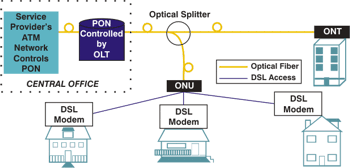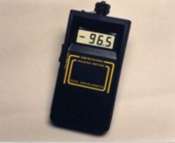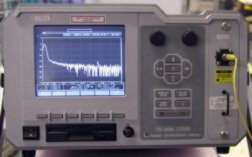OADM: See optical add/drop multiplexer. |
| OAM: Abbreviation for operation, administration, and maintenance. Refers to telecommunications networks. |
OAN: Abbreviation for optical access network. A network technology, based on passive optical networks (PONs), that includes an optical switch at the central office, an intelligent optical terminal at the customer’s premises, and a passive optical network between the two, allowing services providers to deliver fiber-to-the-home while eliminating the expensive electronics located outside the central office. |
|
| OCH: See optical channel. |
| OC-x: Abbreviation for optical carrier. A carrier rate specified in the SONET standard. |
| ODN: Abbreviation for optical distribution network. Term for optical networks being developed for interactive video, audio, and data distribution. |
| O/E: Abbreviation for optical-to-electrical converter. A device used to convert optical signals to electrical signals. Also known as OEC. |

|
| OEIC: Abbreviation for opto-electronic integrated circuit. An integrated circuit that includes both optical and electrical elements. |
| OEM: Abbreviation for original equipment manufacturer. The manufacturer of any device that is designed and built to be distributed under the label of another company. |
| OLT: Abbreviation for optical line termination. Optical network elements that terminate a line signal. |
| OLTS: Abbreviation for optical loss test set. A source and optical power meter combined used to measure optical loss. |
| OMS: Abbreviation for optical multiplex section. A section of a DWDM system that incorporates an optical add/drop multiplexer. |

|
| ONI: Abbreviation for optical network interface. A device used in an optical distribution network to connect two parts of that network. |
|
ONT: Abbreviation for optical network termination. Optical network element that terminates a line signal in installations where the fiber extends into the customer premises. |
| ONU: Abbreviation for optical network unit. A network element that is part of a fiber-in-the-loop system. |
| OOI: Abbreviation for open optical interface. A point at which an optical signal is passed from one equipment medium to another without conversion to an electrical signal. |
| Open Systems Interconnection (OSI): Pertaining to the logical structure for communications networks standardized by the International Organization for Standardization (ISO). |
| Optical Add/Drop Multiplexer (OADM): A device which adds or drops individual wavelengths from a DWDM system. |
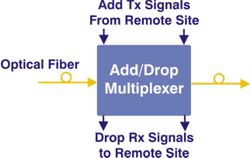
|
| Optical Amplifier: A device that amplifies an input optical signal without converting it into electrical form. The best developed are optical fibers doped with the rare earth element, erbium. See also EDFA. |
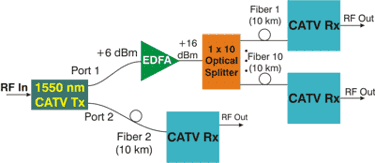
|
| Optical Bandpass: The range of optical wavelengths which can be transmitted through a component. |
| Optical Channel: An optical wavelength band for WDM optical communications. |
| Optical Channel Spacing: The wavelength separation between adjacent WDM channels. |
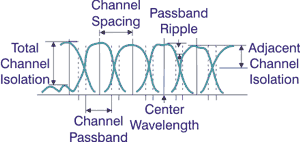
|
| Optical Channel Width: The optical wavelength range of a channel. |
| Optical Continuous Wave Reflectometer (OCWR): An instrument used to characterize a fiber optic link wherein an unmodulated signal is transmitted through the link, and the resulting light scattered and reflected back to the input is measured. Useful in estimating component reflectance and link optical return loss. |
| Optical Directional Coupler (ODC): A component used to combine and separate optical power. |
|
| Optical Fall Time: The time interval for the falling edge of an optical pulse to transition from 90% to 10% of the pulse amplitude. Alternatively, values of 80% and 20% may be used. |
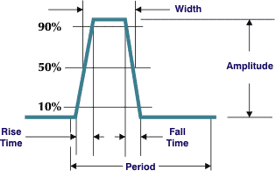
|
| Optical Fiber: A glass or plastic fiber that has the ability to guide light along its axis. The three parts of an optical fiber are the core, the cladding, and the coating or buffer. |
|
| Optical Isolator: A component used to block out reflected and unwanted light. Also called an isolator. |
|
| Optical Link Loss Budget: The range of optical loss over which a fiber optic link will operate and meet all specifications. The loss is relative to the transmitter output power and affects the required receiver input power. |
|
| Optical Path Power Penalty: The additional loss budget required to account for degradations due to reflections, and the combined effects of dispersion resulting from intersymbol interference, mode-partition noise, and laser chirp. |
|
| Optical Power Meter: An instrument that measures the amount of optical power present at the end of a fiber or cable. |
|
| Optical Pump Laser: A shorter wavelength laser used to pump a length of fiber with energy to provide amplification at one or more longer wavelengths. See also EDFA. |
| Optical Return Loss (ORL): The ratio (expressed in dB) of optical power reflected by a component or an assembly to the optical power incident on a component port when that component or assembly is introduced into a link or system. |
| Optical Rise Time: The time interval for the rising edge of an optical pulse to transition from 10% to 90% of the pulse amplitude. Alternatively, values of 20% and 80% may be used. |
 |
| Optical Signal-to-Noise-Ratio (OSNR): The optical equivalent of SNR. |
| Optical Spectrum Analyzer (OSA): A device that allows the details of a region of an optical spectrum to be resolved. Commonly used to diagnose DWDM systems. |
|
| OTDR (Optical Time Domain Reflectometer): An instrument that locates faults in optical fibers or infers attenuation by backscattered light measurements. |
|
| Optical Waveguide: Another name for optical fiber. |
| OSA: See optical spectrum analyzer. |
| OSNR: See optical signal-to-noise ratio. |
| Outside Plant (OSP): In telephony, all cables, conduits, ducts, poles, towers, repeaters, repeater huts, and other equipment located between a demarcation point in a switching facility and a demarcation point in another switching facility or customer premises. |
|
| OXC: Abbreviation for optical cross-connect. See cross-connect. |


